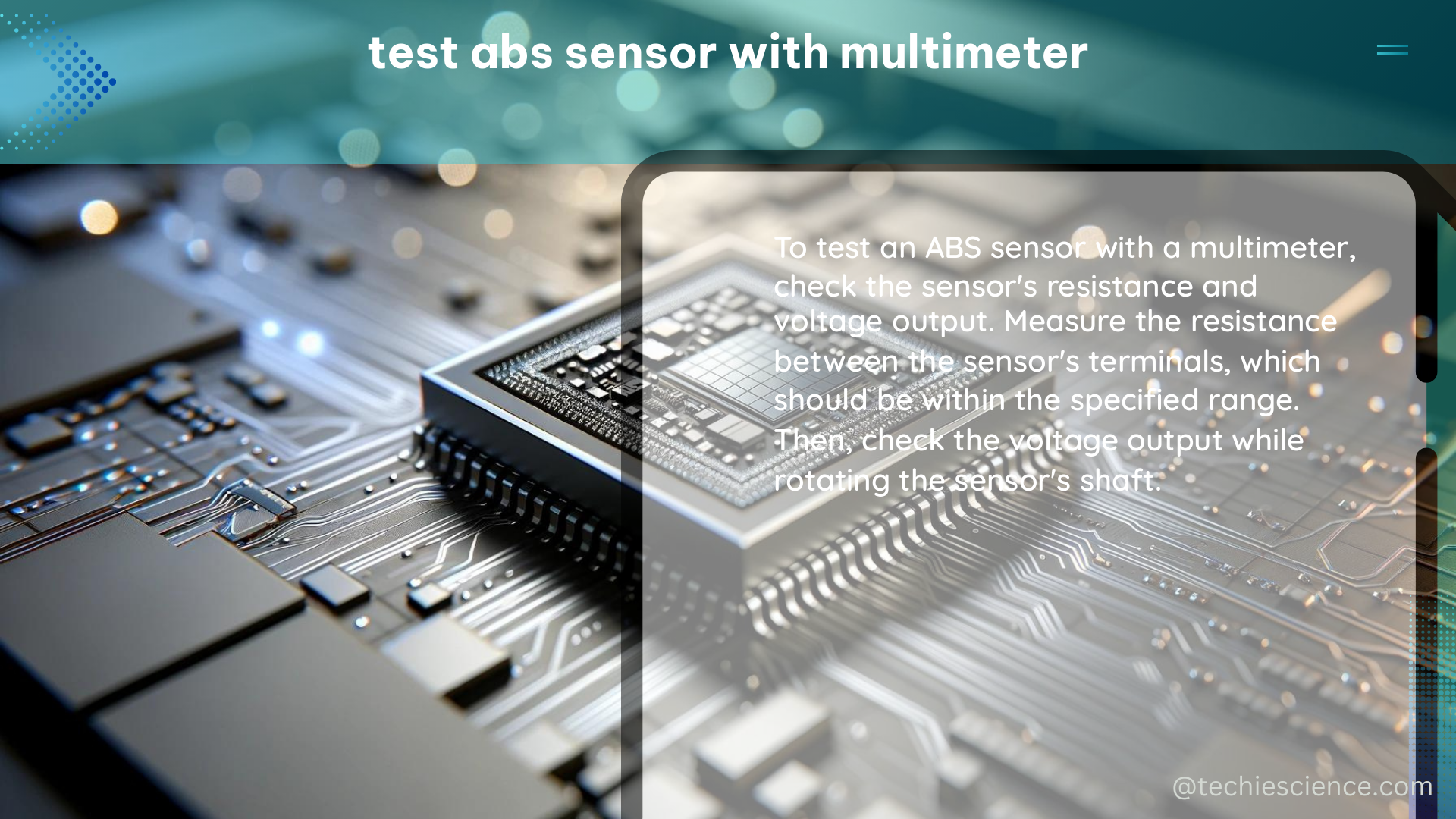Testing the Anti-lock Braking System (ABS) sensor on your vehicle is a crucial step in maintaining the safety and performance of your braking system. This comprehensive guide will walk you through the process of testing an ABS sensor using a multimeter, providing you with the technical details and specific steps to ensure accurate and reliable results.
Understanding ABS Sensors
ABS sensors are essential components in modern vehicles, responsible for monitoring the rotational speed of each wheel. These sensors work in conjunction with the ABS control module to detect and prevent wheel lockup during sudden braking, ensuring the vehicle maintains traction and stability.
There are two main types of ABS sensors:
-
Variable Reluctance (Two-Wire) ABS Sensors: These sensors generate an AC or pulsed DC signal that varies in frequency as the wheel rotates. The signal is then interpreted by the ABS control module to determine the wheel speed.
-
Hall Effect (Three-Wire) ABS Sensors: These sensors use a Hall effect integrated circuit to produce a digital signal that the ABS control module can interpret. The signal is typically a square wave with a frequency proportional to the wheel speed.
Locating the ABS Sensor

The first step in testing an ABS sensor is to locate it on your vehicle. ABS sensors are typically located near the wheel hubs, either on the brake assembly or the suspension components. Consult your vehicle’s service manual or repair information to identify the exact location of the ABS sensor you need to test.
Testing a Two-Wire Variable Reluctance ABS Sensor
-
Set the Multimeter: Set your multimeter to the AC voltage or resistance (ohms) range, depending on the specific test you want to perform.
-
Measure Resistance: With the vehicle’s ignition in the “ON” position, measure the resistance between the two wires of the ABS sensor. The typical resistance range for a variable reluctance ABS sensor is between 1.2 kΩ and 2 kΩ.
-
Test Signal Output: To test the signal output of the ABS sensor, set your multimeter to the AC voltage range and connect the positive and negative leads to the two sensor wires. Slowly rotate the wheel by hand and observe the multimeter’s reading. You should see a pulsing AC voltage signal with a frequency that increases as the wheel speed increases.
-
Typical AC voltage output: 0.5 to 5 volts AC
-
Typical frequency range: 4 to 400 Hz
-
Inspect for Damage: Visually inspect the ABS sensor and its wiring for any signs of damage, such as cracked or frayed wires, loose connections, or corrosion.
Testing a Three-Wire Hall Effect ABS Sensor
-
Set the Multimeter: Set your multimeter to the DC voltage or resistance (ohms) range, depending on the specific test you want to perform.
-
Measure Voltage: With the vehicle’s ignition in the “ON” position, measure the voltage between the power (usually red) and ground (usually black) wires of the ABS sensor. The typical voltage range is 8 to 16 volts DC.
-
Measure Resistance: Measure the resistance between the power and ground wires. The typical resistance range for a Hall effect ABS sensor is between 1 kΩ and 2 kΩ.
-
Test Signal Output: To test the signal output of the ABS sensor, set your multimeter to the DC voltage range and connect the positive lead to the signal (usually white) wire and the negative lead to the ground wire. Slowly rotate the wheel by hand and observe the multimeter’s reading. You should see a pulsing DC voltage signal with a frequency that increases as the wheel speed increases.
-
Typical DC voltage output: 0 to 5 volts DC
-
Typical frequency range: 4 to 400 Hz
-
Inspect for Damage: Visually inspect the ABS sensor and its wiring for any signs of damage, such as cracked or frayed wires, loose connections, or corrosion.
Interpreting Test Results
When interpreting the test results, keep the following in mind:
- If the resistance or voltage readings are outside the expected ranges, the ABS sensor may be faulty and require replacement.
- If the signal output is not present or irregular, the sensor may be malfunctioning, or there could be an issue with the wiring or the ABS control module.
- Consult your vehicle’s service manual or repair information for the specific resistance, voltage, and signal output ranges for your vehicle’s ABS sensor.
Safety Considerations
It is important to note that any repair work to the brake system, including the ABS sensor, should only be carried out by qualified specialists who follow the maintenance and safety instructions provided by the vehicle manufacturer and the product-specific assembly guidelines.
Conclusion
Testing an ABS sensor with a multimeter is a crucial step in maintaining the safety and performance of your vehicle’s braking system. By following the detailed steps and technical specifications outlined in this guide, you can accurately diagnose and troubleshoot any issues with your ABS sensor, ensuring your vehicle’s brakes are functioning properly and keeping you safe on the road.
References
- How to Test Wheel Speed Sensor (ABS) with Multimeter
- Check & Change ABS Sensor
- Testing an ABS Sensor with a Multimeter
- Testing an ABS Sensor with a Multimeter
- ABS Sensor Test with Meter

The lambdageeks.com Core SME Team is a group of experienced subject matter experts from diverse scientific and technical fields including Physics, Chemistry, Technology,Electronics & Electrical Engineering, Automotive, Mechanical Engineering. Our team collaborates to create high-quality, well-researched articles on a wide range of science and technology topics for the lambdageeks.com website.
All Our Senior SME are having more than 7 Years of experience in the respective fields . They are either Working Industry Professionals or assocaited With different Universities. Refer Our Authors Page to get to know About our Core SMEs.